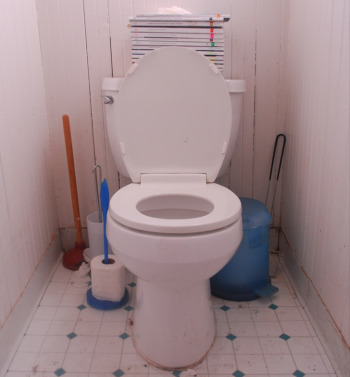 FuelCell Energy: Giving new meaning to the phrase “a powerful poop.”Photo courtesy starryeyez via FlickrIt’s been a crappy week — and I mean that in a good way.
FuelCell Energy: Giving new meaning to the phrase “a powerful poop.”Photo courtesy starryeyez via FlickrIt’s been a crappy week — and I mean that in a good way.
On Wednesday, I wrote about the California egg farm that bought a 1.4-megawatt fuel cell powered by biogas produced from chicken poo. (Forget free-range eggs; carbon-free could become all the rage with fashion-forward foodies.)
Now the company that makes the fuel generator, FuelCell Energy, said it has signed a deal to provide two 300-kilowatt fuel cells to a Southern California water district that will install the devices in wastewater treatment plants. These fuel cells will also be powered by biogas derived from wastewater — i.e. what swirls down your toilet.
You get the picture.
An anaerobic digester at the Perris Valley Regional Water Reclamation Facility in Riverside County will remove methane, a potent greenhouse gas, from the, er, “biosolids,” which will provide the fuel for the fuel cells.
Heat produced by the fuel cells will be used to help power the digester, creating what engineers call a closed-loop system. That will take pressure off the power grid and help California utilities meet a mandate to obtain a third of their electricity from renewable sources by 2020.
“We installed our first fuel cell power plant about two years ago and have been very pleased with the reliability of the system,” Ron Sullivan, president of the board of the Eastern Municipal Water District, said in a statement. “We operate around the clock and value the energy security that an on-site fuel cell provides, which is about 40 percent of our total electrical demand at that plant.”
Gordie Hanrahan, a spokesperson for FuelCell Energy, said he could not comment on the costs of the Riverside County fuel cells. But he noted that a 600-kilowatt system installed for a farm customer in California last year cost $9.5 million and had a projected annual energy savings of $700,000. When various incentives and other savings are taken into account, the payback time is estimated to be six years.
A big benefit of fuel cells in smoggy Southern California is that besides emitting virtually no carbon dioxide they also produce nearly zero nitrogen oxide, sulfur dioxide, and particulate matter — all of which are strictly regulated by the state and pose a health hazard.
“The ultra-clean power generation by the fuel cell power plant was an important aspect of our purchasing decision,” noted Sullivan.
Priming the pump was a $2.7 million grant that the state of California awarded to the water district for the purchase of the fuel cells.
Now that’s money that won’t go down the drain.




